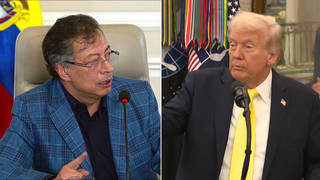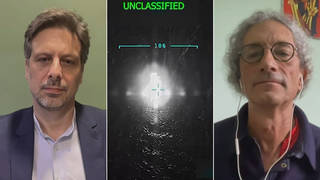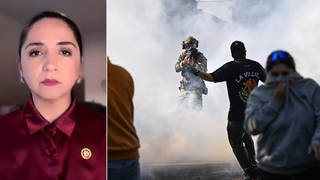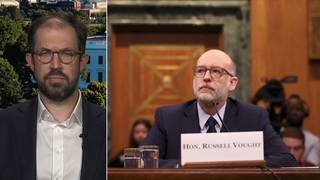
Guests
- Yoruba Richendirector and producer of The New York Times documentary The Killing of Breonna Taylor.
Months after the police killing of Breonna Taylor in Louisville, Kentucky, new details have emerged about the final moments of the 26-year-old EMT’s life and the police raid that brought it to a violent end, as detailed in a New York Times documentary that includes dozens of interviews and a review of more than 1,200 new photos of the crime scene. Taylor, whom police shot five times in her own home on March 13, has since become a household name and rallying point in the national movement for racial justice. The police officers responsible for her death have not been charged. We speak with Yoruba Richen, director and producer of “The Killing of Breonna Taylor,” who says the case exposes the systemic violence at the heart of U.S. policing.
Transcript
AMY GOODMAN: This is Democracy Now!, democracynow.org, The Quarantine Report. I’m Amy Goodman.
Hundreds of antiracist protesters faced armed right-wing men brandishing long guns in Louisville, Kentucky, Saturday as they gathered ahead of the Kentucky Derby to demand justice for Breonna Taylor, the 26-year-old Black emergency room technician who was fatally shot by Louisville police in her own home in March. Protesters hoped to use the 146th Kentucky Derby, already months delayed due to the pandemic, to draw attention to Taylor’s case. They said police did little to intervene as a group of mainly white armed so-called counterprotesters carrying American flags chanted “U.S.A.” and “Back the blue” and attempted to intimidate the demonstrators.
On Monday, the Louisville mayor announced a new interim police chief, Yvette Gentry. She’s the first Black woman to fill the role.
This comes as more then 1,200 new photos of the crime scene at the Louisville apartment where police shot and killed Breonna Taylor show a scene of chaos that unfolded on March 13th, when plainclothes police officers using a no-knock search warrant broke down Breonna Taylor’s door supposedly in search of drugs. Taylor was in bed with her boyfriend Kenneth Walker, who reached for his gun and fired a shot, thinking there was an intruder in the apartment. Three officers then opened fire, hitting Breonna Taylor five times. The crime scene photos show bullet holes and pieces of bullets in every room of the apartment and in two adjacent apartments.
One of the officers, Brett Hankison, was fired in June for shooting blindly from outside of the apartment, including through a covered patio window and door into Breonna’s bedroom. The other two officers, Jonathan Mattingly and Myles Cosgrove, are on administrative leave. But none of the officers who killed Breonna Taylor have been charged.
On Friday, The New York Times released a documentary about Breonna Taylor’s life and death. It’s called The Killing of Breonna Taylor. This is the trailer.
KENNETH WALKER: The last thing she said was “Turn off the TV.” The next thing I remember is a loud bang at the door.
911 OPERATOR: 911. Where is your emergency?
KENNETH WALKER: Somebody kicked in the door and shot my girlfriend. Bre! Help!
TAMIKA PALMER: No one never told me really what happened. I didn’t find out that she was shot by a police officer ’til I saw it on the news.
KATRINA CURRY: She had a very inviting personality. She always had like a problem-solver attitude.
PREONIA FLAKES: The media tried to assassinate Breonna’s character. We can’t keep quiet.
SAM AGUIAR: Immediately there were red flags. There were bullet holes everywhere. It was a war zone in there.
TOM WINE: Once the shooting occurred, they never searched the apartment any further.
PROTESTERS: Say her name! Breonna Taylor!
REP. CHARLES BOOKER: Justice needs to be rendered. The question is: Will that happen?
TAMIKA PALMER: It has to stop.
AMY GOODMAN: That’s the trailer for The Killing of Breonna Taylor. It’s airing on FX and FX on Hulu.
Well, for more, we go to Newburgh, New York, where we’re joined by the film’s director and producer Yoruba Richen. She’s the director of the documentary program at the Graduate School of Journalism at CUNY.
We welcome you back to Democracy Now! It’s great to have you with us, Yoruba. Can you talk about this six months after the killing of Breonna Taylor? Take us through what has happened, but start with what we know about that fateful night.
YORUBA RICHEN: Thank you, Amy. It’s great to be here again and to see you and to be on the show.
What we know about that night is that there were five no-knock warrants that the Louisville Metro Police Department, LMPD, were able to obtain, five warrants on different apartments, one of who was Breonna Taylor’s ex-boyfriend, Jamarcus Glover, and one of which was on Breonna Taylor’s apartment. They were able to obtain these warrants because they say they had evidence that showed that Breonna was going to — was seen at Jamarcus Glover’s house in January and, you know, sometime in February, that Jamarcus had used her name — her address as his address. And they said that was the — that was the reason they gave for thinking that there may be drugs or money at Breonna’s apartment.
Now, the lawyers and Breonna’s family say that that was not up-to-date information and that, in fact, in order to obtain these warrants, you need to have very up-to-date information, in the last 42 or 78 hours. And the last time, apparently, that they had updated this information was in February, and this event occurred on March 13th. So, there’s an issue with whether these warrants were valid.
We know that the warrants were — the warrant at Breonna’s house was not executed correctly, because she ended up dead. The way that — there’s questions about how they were executed, if they announced — if the police announced themselves loud enough. The police say that they did announce themselves as they were breaking into the apartment. Kenneth Walker, her boyfriend, who was the survivor of that night, says he didn’t hear them. And as a legal, licensed gun owner, as they were breaking into his apartment, he shot one shot, because he thought they were being broken into. He didn’t know what was happening. And then, obviously, the barrage of shots, and Breonna was killed.
And then, after that, Kenny was taken into custody immediately, and we have harrowing video from the neighbor you see in the film of him being taken into custody and being — you know, saying that he didn’t know what happened. We thought — they were lying, they were in bed, you know, when they heard the doors being banged on. And he ended up spending two weeks in jail, until he was let out of jail. He didn’t know what happened. You know, he found out on the news what happened to his girlfriend, when he was in prison.
Meanwhile, Tamika Palmer, Breonna’s mother, had gotten a call from Kenny that night as these events were happening. She ended up rushing down to Breonna’s apartment. She doesn’t live far to the apartment complex. She was told by the officers, by the police there, to go to the hospital, when no one was at the hospital, so unclear why they told her to do that. She waited there, the hospital, for a couple hours. The hospital told her that, you know, there’s no one that has — you know, that no one has been — that Breonna was not there. Then she went back and waited, to the apartment complex, waited a few more hours, and then finally asked — was told that Breonna was still in the apartment. And so, she knew that she had passed away, that she was dead, when she found that out. And she did not know that police had shot her, until the next day on the news. She was not given this information. So, it’s that —
AMY GOODMAN: I wanted to go back, Yoruba, with Kenneth Walker, her boyfriend.
YORUBA RICHEN: Sure.
AMY GOODMAN: I mean, he takes his legal weapon — they’re in bed, their house is broken into — and he fires a shot. He then calls the police himself. That 911 call we heard, he’s calling the police to ask for help for an intruder.
YORUBA RICHEN: Absolutely. He called the police himself. He had previously called, as I said, Tamika and his — Breonna’s mom, and his own mom. And then called the police. And he’s — yeah, I mean, it’s right in the call. You hear what he’s saying. He’s saying he doesn’t know what’s happening. Someone shot his girlfriend. And he’s crying. So —
AMY GOODMAN: I want to go to a longer version of that clip, that 911 call that Kenneth Walker makes to the police that night.
KENNETH WALKER: I don’t — I don’t know what’s happening. Somebody kicked in the door and shot my girlfriend. … Bre! Oh my god!
911 OPERATOR: You said 26? Where was she shot at?
KENNETH WALKER: I don’t know. She’s on the ground right now. I don’t know. … Help! Oh my god! Breonna’s so ill! Help!
911 OPERATOR: What’s her name, sir? Is she alert and able to talk to you?
KENNETH WALKER: No!
AMY GOODMAN: Yoruba Richen?
YORUBA RICHEN: I mean, it’s absolutely — I think you hear the — I mean, you hear it all in his voice. He doesn’t know what’s happened. Breonna is shot, on the floor. You know, I can only — I can’t even imagine what that must feel like for him. You know, they were in bed, lying in bed. He describes that night. He hears — they hear the breaking in of the door. They get dressed really as quickly as possible. Breonna is screaming out, “Who is it? Who is it?” Kenneth said there’s no answer. Kenny says there’s no answer, no answer. And then, when they breach, when the door comes — you know, breach the door, coming — you know, falling in, is when he let off a shot, because he thought they were being broken into.
AMY GOODMAN: So, I want to go to another clip from your film, The Killing of Breonna Taylor, where we hear from one of Breonna’s neighbors, who wished to remain unnamed, but first to Breonna’s mother, Tamika Palmer.
TAMIKA PALMER: So I started calling him, and he wasn’t answering the phone. So I started calling Breonna, and she wasn’t answering.
NEIGHBOR: I’m roughly a hundred1 feet from her apartment. My apartment does physically touch hers in the top right corner, so all that was between me and the house I was, the screen door. And I’m sitting there watching TV. It was a little past midnight or whatever. And I hear a pop, pop, pop. Immediately after that, I heard two more pops. And that’s when I pulled my blinds open to see what was happening outside. It sounded like the O.K. Corral.
AMY GOODMAN: And in this clip from the documentary The Killing of Breonna Taylor, we hear from Donavis Duncan, a Louisville police officer who lives in the same apartment complex as Breonna, but first, Breonna’s mother, Tamika Palmer.
TAMIKA PALMER: We stood out there 'til about almost 5 in the morning. It just made no sense. Like, there's all these police out there, and nobody is telling me anything. I don’t know why any of this is happening. I said, “Well, where is Breonna? I need to see Breonna.”
DONAVIS DUNCAN: I told them, “Just hold on one second. I’m not at liberty to say anything that happened.” And then I went to go get a detective. And they went and spoke to Breonna’s family at that point in time.
TAMIKA PALMER: It was about 11:00 in the morning when he comes back over and says they were almost done. And I said, “OK, that’s fine, but where is Breonna?” And that’s when he said, “Well, ma’am, she’s still in the apartment.” So, I knew then what that meant.
AMY GOODMAN: Again, that was Breonna’s mother, Tamika Palmer, and, before that, Donavis Duncan. Tell us about the Louisville police officer who lives in the same complex.
YORUBA RICHEN: Well, Officer Duncan, he lives in the complex that Breonna lived in, and he does security there. So, he — it’s kind of like his second job. So, he didn’t know the events, you know, what was going on, until he got a call on his — or, until he was notified. And then he went down there to see what’s going on, so he was in the dark, as well. And he was really just trying to help the process along, I guess, in terms of separating the public from what was happening around Breonna’s apartment.
AMY GOODMAN: So, it’s six months ago this week that Breonna was killed. Give us the timeline, Yoruba, on the reaction then, what people understood, and then what happened after the killing of George Floyd, how this case has grown to the point where this weekend at the Kentucky Derby, six months later, the massive protests are happening, the protests on the property of the attorney general, the first African American attorney general of Kentucky, and so much more.
YORUBA RICHEN: Yeah. So, after March 13th, the night she was — the early morning of March 13th, when she was killed, there was — Tamika did not get much information, or any information really, from the police. And she called a lawyer, Sam Aguiar and Lonita Baker, who are her representatives, and went in to meet with them. And they immediately were struck by what had been in the press. And the press had said, “Drug suspect killed,” or “Suspect killed in drug probe.” That’s how they were — you know, that’s how — “And cop was shot.” And that’s how it was being presented. And there was a sense that something was off here, that this was not the entire story. So, they started to take on the case and doing their own investigation.
Meanwhile, the friends and family of Breonna started on social media and saying that this narrative was wrong that the media was putting out there. Kenny was still in jail. He was being called, you know, a cop — shooting a cop. Breonna was dead. She was called a suspect in a drug probe. And they knew that this was not — you know, that this was not the story. So they began to tweeting and putting their social — you know, putting the information out on social media that this needs to be investigated, we need to know what’s going on, Kenny needs to be freed.
And still, it wasn’t until the killing of George Floyd that this case — and then, of course, corona shut everything down just a few days after this. And combined with that and the fact that there was no video in this case, as there had been video in these other harrowing events of Black people being shot by police — wasn’t the case here that there was video, or at least video that was being released. We don’t actually know what video is out there, because the LMPD has not given any information, nor have the results of either investigation are released — and I’ll get to that in a second. But it was the killing of George Floyd that people started to focus more attention on what happened to Breonna Taylor.
And in the city of Louisville itself, we get protests, and repeated protests began and really, really elevated, until there was a takeover of Jefferson Square, which is an area right in the downtown Louisville, where all the LMPD is, where the courts are, and the protesters took over that square and renamed it Breonna Taylor — renamed it for Breonna Taylor. So, the protests have escalated, and with that, of course, the national and international attention. Now, at the same time, the reason why the protests have escalated, because the LMPD has not released any information, pretty much, and in fact they put out a blank incident report a couple months later that said that there were no injuries to Breonna. And that just enraged people even more.
AMY GOODMAN: I mean, this is absolutely amazing. This incident report, when it says injuries, it says “none.” When it says was force used to enter the apartment, it says “none,” when, of course, they used a battering ram. And, of course, Breonna Taylor was shot multiple times.
YORUBA RICHEN: It’s an outrage. I mean, what else can you say? And it fueled the anger of the community, rightly so. And meanwhile, the LMPD, again, has said nothing. At that point, Hankison, one of the officers, was fired, but that took a few months for that to happen. And the other officers are still employed by the LMPD.
Also, the investigations — so, there are two investigations that are going on that people are waiting for. The attorney general, Daniel Cameron, who you mentioned, he has — it’s an independent investigation that was turned over to his office, and then the FBI has been investigating, as well. And the attorney general are investigating — the investigation in his office are looking at the events that happened that night. We know — he’s given no timeline of when those results will be released.
We found out a big thing that folks were waiting for, that we were told that people were waiting — you know, that the investigation was waiting for, is the ballistics report, which will show which officer — which bullets hit Breonna. So that’s still unknown. And that’s part of the reason — that’s the reason why no officers have been charged, because they do not know which — the ballistics report has to tell them which officers — which bullets hit Breonna. We found out, I believe last week, the beginning of last week, that those ballistics reports has been released. They’re in the AG’s hands, but yet still no timeline on when the results will be released.
AMY GOODMAN: So, let’s talk about Hankison for a minute, because you go deeply into his record, and, to say the least, you flesh it out. Hankison is the one who shot in from outside the apartment through a window, and he’s the one who’s fired for what? Firing blindly.
YORUBA RICHEN: Exactly.
AMY GOODMAN: But he — after Breonna’s death, a woman saw the names of the officers and said, “My god, that’s the guy who went after me, who assaulted me, sexually harassed me.”
YORUBA RICHEN: Yes.
AMY GOODMAN: Explain Hankison’s record, now that’s coming out more and more as one woman after another comes out.
YORUBA RICHEN: Yeah. So, Hankison has a record, previous to this, of charges, an excessive force and different charges filed in his police record. And none of that — you know, all of those have been either cleared or dismissed. So, there’s that.
Then, as you mentioned, when this case started getting attention, a young woman, who we interviewed in the film, wrote on Facebook about her encounter with Hankison at a bar, where he does security and asked her if she wanted a ride home late at night. And she said yes. You know, he was an officer. She, you know, thought —
AMY GOODMAN: In his uniform. He picks her up.
YORUBA RICHEN: In his uniform.
AMY GOODMAN: She was walking home from the bar, about 10 minutes away, and he pulled over, said, “Do you want me to give you a ride home?”
YORUBA RICHEN: Exactly. And she gets in the car. She says immediately he starts rubbing her leg, calling her “baby.” You know, she started getting really scared. She knew this was wrong. And when she gets out, she — when she gets to her house, she flies out of the car and, you know, goes — tries to get away from him as quickly as possible. She texts her friend that night that this — what happened, and that he was an officer and this creepy — what, she says, “creepy cop” did to her. And her friend immediately files a report on the portal of the LMPD about what happened. And no response.
Then, as this case comes to light, she tells her boyfriend — Emily tells her boyfriend that that’s the same cop. He calls the LMPD and files — tries to file a complaint. Nothing. So she posted on Facebook. She posts what’s happened to her on Facebook, and she starts getting all of these other women coming forward, a few other women coming forward and saying they did — they had similar encounters with Hankison, you know, similar sexual misconduct encounters with Hankison. And two of the women, Emily and a woman named Margo Borders, have talked to the FBI in their investigation of this case.











Media Options